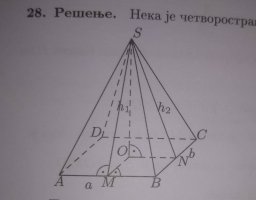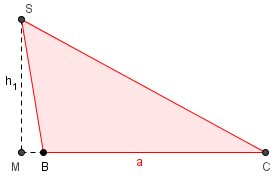The geometric problem I came across left me stunned. For some reason, to me it seems like it's assuming that altitude of the shorter side of a parallelogram is practically the same as a line that connects midpoints of parallel ( and equal ) sides of a given parallelogram. Confusingly, this seems to be the assumption required to solve the problem at all.
Here's the problem:
The base of a pyramid is a parallelogram whose sides are 10cm and 15cm, and the area of its base equal to 90cm^2. The height of the pyramid passes through the intersection of the diagonals of the base and equals 6cm. Calculate the area of the wrapper of the pyramid.
The official solution instructs assignment of values 10 and 15 to sides a and b respectively. Then it names a point O, representing the orthogonal projection of the top point of the pyramid ( that it names S ) on the base of the pyramid. Then, it names orthogonal projections of the point O upon sides a and b - M and N, respectively. HOWEVER, now the official solution assumes the thing I don't understand: If we indicate altitudes of the parallelogram adequate to sides a and b using ha and hb respectively, then OM = ha/2 and ON = hb/2. I attached the picture of the pyramid given in the solution.
I don't quite see how altitude of the shorter side of the parallelogram even necessarily crosses the center of the base ( point of intersection between the base and the height of the pyramid ), let alone ( and this is the most important point ) why that altitude divides the side it passes from and to in half.
I would greatly appreciate any help in understanding this conceptually, as the latter part of the solution to this, once the foregoing dilemma is dispelled, is quite trivial, for which reason I didn't bother showing it here ( In short, it consists of simply getting the values of ha and hb from the value of the base and the two sides, then applying Pythagorean theorem to deduce h1 and h2, ultimately using them alongside the values of sides given in the problem itself to calculate the areas of the 4 triangles.
Thanks in advance.
Here's the problem:
The base of a pyramid is a parallelogram whose sides are 10cm and 15cm, and the area of its base equal to 90cm^2. The height of the pyramid passes through the intersection of the diagonals of the base and equals 6cm. Calculate the area of the wrapper of the pyramid.
The official solution instructs assignment of values 10 and 15 to sides a and b respectively. Then it names a point O, representing the orthogonal projection of the top point of the pyramid ( that it names S ) on the base of the pyramid. Then, it names orthogonal projections of the point O upon sides a and b - M and N, respectively. HOWEVER, now the official solution assumes the thing I don't understand: If we indicate altitudes of the parallelogram adequate to sides a and b using ha and hb respectively, then OM = ha/2 and ON = hb/2. I attached the picture of the pyramid given in the solution.
I don't quite see how altitude of the shorter side of the parallelogram even necessarily crosses the center of the base ( point of intersection between the base and the height of the pyramid ), let alone ( and this is the most important point ) why that altitude divides the side it passes from and to in half.
I would greatly appreciate any help in understanding this conceptually, as the latter part of the solution to this, once the foregoing dilemma is dispelled, is quite trivial, for which reason I didn't bother showing it here ( In short, it consists of simply getting the values of ha and hb from the value of the base and the two sides, then applying Pythagorean theorem to deduce h1 and h2, ultimately using them alongside the values of sides given in the problem itself to calculate the areas of the 4 triangles.
Thanks in advance.




